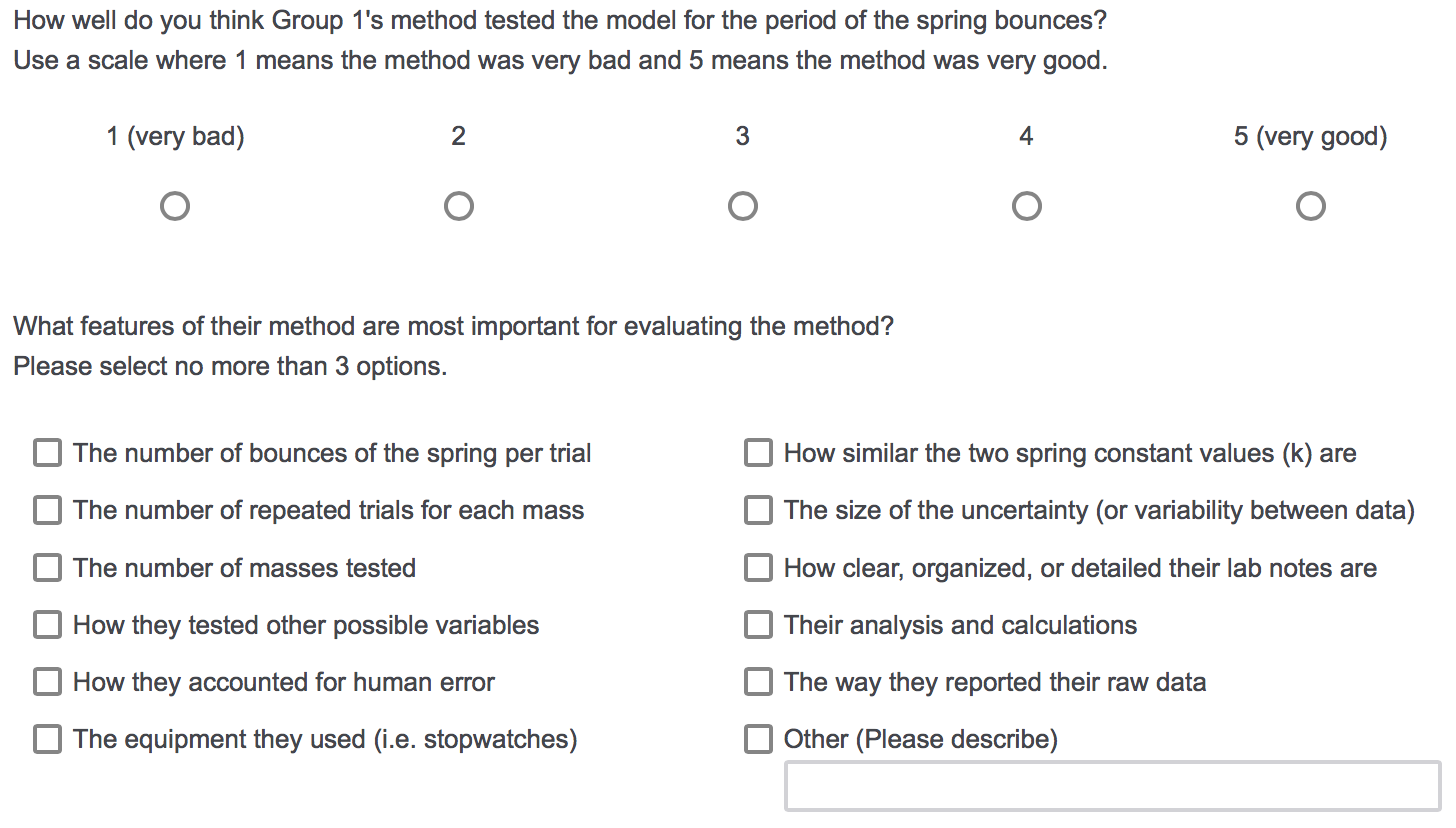Developed by N.G. Holmes, C.E. Wieman, K.N. Quinn, C.J. Walsh, & the Cornell Physics Education Research Lab
| Purpose | To assess how students critically evaluate experimental methods, data, and models. |
|---|---|
| Format | Pre/post, Multiple-choice, Multiple-response, Agree/disagree |
| Duration | 20-30 min |
| Focus | Lab skills (comparing measurements with uncertainty, evaluating data fitted to a model, generating and evaluating conclusions based on data, designing and evaluating experimental methods) |
| Level | Upper-level, Intermediate, Intro college, High school |

PLIC Implementation and Troubleshooting Guide
Everything you need to know about implementing the PLIC in your class.
Login or register to download the implementation guide.
more details
This is the second highest level of research validation, corresponding to at least 5 of the validation categories below.
Research Validation Summary
Based on Research Into:
- Student thinking
Studied Using:
- Student interviews
- Expert review
- Appropriate statistical analysis
Research Conducted:
- At multiple institutions
- By multiple research groups
- Peer-reviewed publication
The questions on the PLIC came from an experiment conducted in an introductory physics lab, initially based on the series of questions an expert posed to themselves when conducting the experiment. These were then refined several times through think-aloud interviews with introductory and upper-division physics students (majors and non-majors), as well as through open-response question responses. The PLIC is still under development.
References
- G. Geschwind, M. Alemani, M. Fox, P. Logman, E. Tufino, and H. Lewandowski, Development of a global landscape of undergraduate physics laboratory courses, Phys. Rev. Phys. Educ. Res. 20 (2), 020117 (2024).
- N. Holmes and H. Lewandowski, Investigating the landscape of physics laboratory instruction across North America, Phys. Rev. Phys. Educ. Res. 16 (2), 020162 (2020).
- N. Holmes and C. Wieman, Preliminary development and validation of a diagnostic of critical thinking for introductory physics labs, presented at the Physics Education Research Conference 2016, Sacramento, CA, 2016.
- N. Holmes and C. Wieman, Assessing modeling in the lab: Uncertainty and measurement, presented at the 2015 Conference on Laboratory Instruction Beyond the First Year of College, College Park, MD, 2015.
- N. Holmes, C. Wieman, and D. Bonn, Teaching critical thinking, Proc. Natl. Acad. Sci. 112 (36), 11199 (2015).
- P. Pirinen, A. Lehtinen, and N. G. Holmes, Impact of traditional physics lab instruction on students’ critical thinking skills in a Finnish context, Eur. J. Phys. 44 (3) 035702 (2023).
- K. Quinn, C. Wieman, and N. Holmes, Interview Validation of the Physics Lab Inventory of Critical thinking (PLIC), presented at the Physics Education Research Conference 2017, Cincinnati, OH, 2017.
- C. Walsh and N. Holmes, Assessing the assessment: Mutual information between response choices and factor scores, presented at the Physics Education Research Conference 2019, Provo, UT, 2019.
- C. Walsh, H. Lewandowski, and N. Holmes, Skills-focused lab instruction improves critical thinking skills and experimentation views for all students, Phys. Rev. Phys. Educ. Res. 18 (1), 010128 (2022).
- C. Walsh, K. Quinn, C. Wieman, and N. Holmes, Quantifying critical thinking: Development and validation of the physics lab inventory of critical thinking, Phys. Rev. Phys. Educ. Res. 15 (1), 010135 (2019).
PhysPort provides translations of assessments as a service to our users, but does not endorse the accuracy or validity of translations. Assessments validated for one language and culture may not be valid for other languages and cultures.
| Language | Translator(s) | |
|---|---|---|
| Chinese | Jin Wang and Suyu Wang |  |
| Finnish | Pekka Pirinen and Antti Lehtinen |  |
| German | Burkhard Priemer and Christoph Maut |  |
| Spanish | Javier Carro |  |
If you know of a translation that we don't have yet, or if you would like to translate this assessment, please contact us!
| Typical Results |
|---|
There are currently no published results for the PLIC, as it is under development. When you give the PLIC to your students using the developers online system, you will receive a report back with overall and question by question comparison data from other classes similar to yours. |
The latest version of the PLIC, released in 2020, is version 2. Version 1 was released in 2017. Instructors can choose to use version 1 or version 2 when they complete the Course Information survey.



